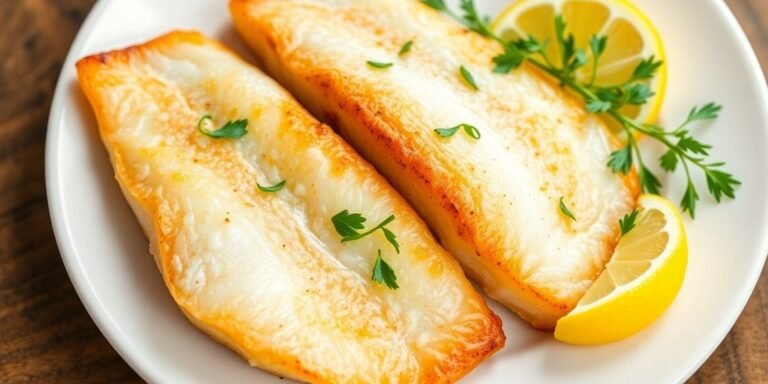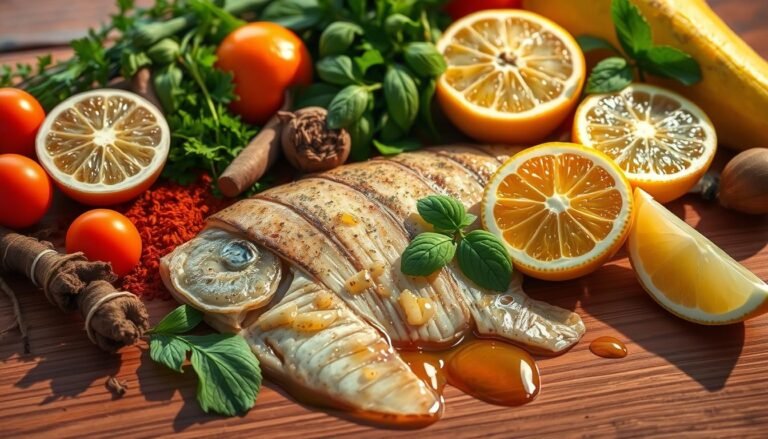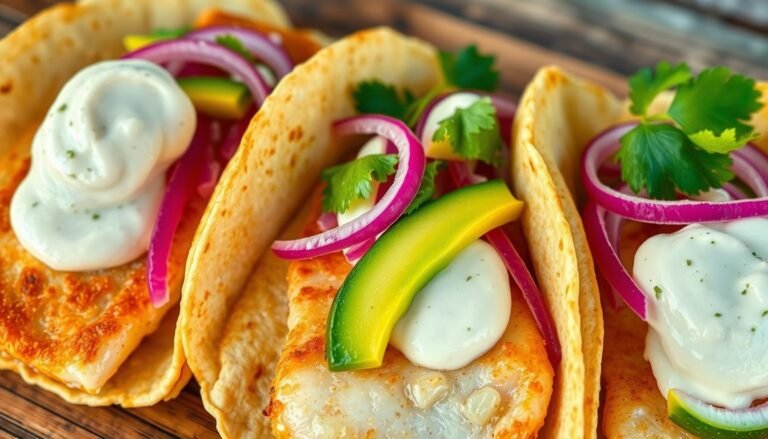Cooking a crispy pan fried snapper is a culinary delight that can be achieved with the right techniques and ingredients. The key to a perfectly cooked snapper lies in the preparation and cooking method.
To start, selecting a fresh snapper is crucial. When cooked correctly, snapper can be incredibly tender and flavorful, with a crispy exterior that enhances its natural taste.
By following a simple recipe and using the right cooking techniques, you can create a crispy fish recipe that will impress your family and friends. This article will guide you through the process, providing tips on how to achieve a crispy exterior while maintaining the tender flesh inside.
Key Takeaways
- Selecting the right snapper is crucial for a great dish.
- A crispy exterior can be achieved with the right cooking techniques.
- Preparation is key to a perfectly cooked snapper.
- Simple recipes can lead to impressive culinary results.
- Maintaining tender flesh inside is as important as achieving a crispy outside.
The Perfect Crispy Pan Fried Snapper: An Overview
The allure of a perfectly cooked, crispy pan-fried snapper lies in its texture and flavor contrast. This dish is a staple in many cuisines, particularly in coastal regions where fresh snapper is readily available.
Why Snapper Makes an Excellent Choice for Pan Frying
Snapper is a firm-fleshed fish that absorbs flavors well and has a mild taste, making it ideal for pan-frying. Its texture holds up nicely to the cooking process, resulting in a crispy exterior and a tender interior. According to culinary experts, red snapper is a popular choice for frying due to its flavor and texture.
Key Benefits of This Cooking Method
Pan-frying offers several benefits, including quick cooking times and the ability to achieve a crispy crust on the fish. This method also allows for a high degree of control over the cooking process, ensuring that the snapper is cooked to perfection. The table below highlights some key advantages of pan-frying snapper.
| Benefit | Description |
|---|---|
| Crispy Exterior | Achieved through proper coating and frying techniques |
| Tender Interior | Result of cooking the fish at the right temperature |
| Flavor Retention | Pan-frying helps lock in the natural flavors of the snapper |
Essential Ingredients for Crispy Pan Fried Snapper
To achieve the perfect crispy pan-fried snapper, it’s crucial to start with the right ingredients. The quality of your dish depends heavily on the freshness and type of snapper you choose, as well as the seasonings and oils you use.
Selecting the Right Snapper in Australian Markets
Australian markets offer a variety of snapper species, with red snapper and pink snapper being popular choices. When selecting snapper, look for fish with clear eyes, red gills, and a pleasant ocean smell.
Red Snapper vs. Pink Snapper: Local Varieties
Red snapper has a slightly sweeter flavor and firmer texture, while pink snapper is often more tender. Both are excellent for pan-frying, so the choice largely depends on personal preference and availability.
Seasoning and Coating Options
For a crispy coating, a mixture of flour, breadcrumbs, and spices works well. You can also experiment with various seasonings like lemon pepper, garlic powder, or paprika to add flavor. Consider using fresh herbs like parsley or dill for added freshness.
Oil Selection for the Perfect Crisp
The right oil is crucial for achieving a crispy exterior. Canola or avocado oil are excellent choices due to their high smoke points, ensuring your snapper cooks evenly without burning. Using the right oil will help you achieve that perfect crisp.
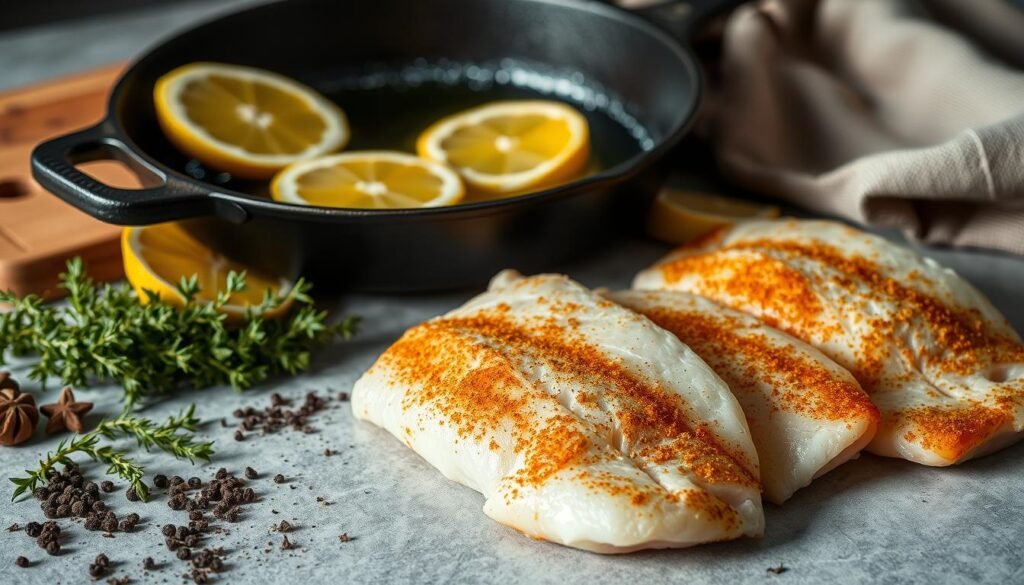
Kitchen Equipment You’ll Need
To achieve the perfect crispy pan-fried snapper, having the right kitchen equipment is crucial. The quality of your cookware can significantly impact the outcome of your dish.
Choosing the Right Pan
For pan-frying snapper, a heavy-bottomed pan is recommended. This type of pan distributes heat evenly, which is essential for achieving a crispy exterior.
Cast Iron vs. Non-Stick Considerations
Two popular options for pan-frying are cast iron and non-stick pans. Cast iron pans retain heat exceptionally well and can achieve a superior crust on the fish. However, they require more maintenance than non-stick pans. Non-stick pans, on the other hand, offer easier food release and cleanup but may not achieve the same level of crispiness as cast iron.
Other Essential Tools
In addition to the right pan, other essential tools include:
- A thermometer to check oil temperature
- Tongs for handling the fish
- A plate or tray for coating the snapper
Having these tools on hand will make the cooking process smoother and more efficient, ensuring your crispy fish recipe turns out perfectly.
Preparing Your Snapper Before Cooking
The key to a mouth-watering crispy pan fried snapper lies in its preparation before cooking. Proper preparation not only enhances the flavor but also ensures a delightful texture.
Cleaning and Scaling Techniques
Before cooking, it’s crucial to clean and scale your snapper. Start by rinsing the fish under cold water, then pat it dry with paper towels. Scaling involves removing the scales, usually with a fish scaler or the back of a knife. Make sure to clean the cavity thoroughly, removing any innards and bloodlines.
Filleting vs. Whole Fish Preparation
You can prepare your snapper either as fillets or whole fish. Filleting involves removing the bones and skin, resulting in tender pieces ideal for pan-frying. Whole fish preparation retains the bones and skin, which can enhance flavor and texture. To decide, consider your personal preference and the desired presentation.
How to Ask Your Fishmonger for Proper Preparation
If you’re not comfortable preparing the snapper yourself, ask your fishmonger for assistance. Request that they scale and clean the fish, and specify whether you want it filleted or left whole. A professional fishmonger can provide valuable advice and ensure your snapper is prepared correctly for cooking.
Dry Brining for Extra Flavour and Crispiness
Dry brining involves rubbing the fish with salt and letting it sit before cooking. This process enhances flavor and helps achieve a crisper exterior when pan-frying. To dry brine your snapper, sprinkle both sides with salt and let it rest in the refrigerator for about 30 minutes before rinsing and cooking.
By following these steps, you’ll be well on your way to creating a delicious crispy pan fried snapper. Remember, the key to success lies in the preparation.
Seasoning and Coating Your Snapper
Achieving the perfect crispy pan-fried snapper begins with the right seasoning and coating techniques. To create a truly delicious dish, it’s essential to understand how to balance flavors and textures.
Basic Seasoning Combinations with Australian Herbs
Australian herbs offer a unique flavor profile that can elevate your snapper dish. Consider combining lemon myrtle with native thyme for a refreshing twist. Another option is to blend Davidson’s plum with a hint of garlic for a savory flavor. For a simple yet effective seasoning, mix salt, pepper, and a sprinkle of paprika.
Flour Dredging Techniques
Flour dredging is a crucial step in achieving a crispy coating. To start, season your flour with salt, pepper, and any desired herbs. Then, gently coat the snapper fillets in the flour mixture, shaking off any excess. For an extra crispy coating, you can dip the floured snapper in a lightly beaten egg before dredging it again in flour. Check out this crispy fish recipe for more detailed instructions on how to fry snapper.
Alternative Coatings for Different Textures
For those looking to experiment with different textures, alternative coatings can be a great option. Breadcrumbs can add a satisfying crunch, while parmesan cheese can provide a rich, savory flavor. You can also try using panko breadcrumbs for an even lighter coating.
By mastering these seasoning and coating techniques, you’ll be well on your way to creating a mouth-watering crispy pan-fried snapper that’s sure to impress.
Mastering the Crispy Pan Fried Snapper Technique
To cook a truly exceptional crispy pan fried snapper, one must pay attention to several crucial details. The process involves more than just placing the fish in a hot pan; it’s about understanding the subtleties that make all the difference.
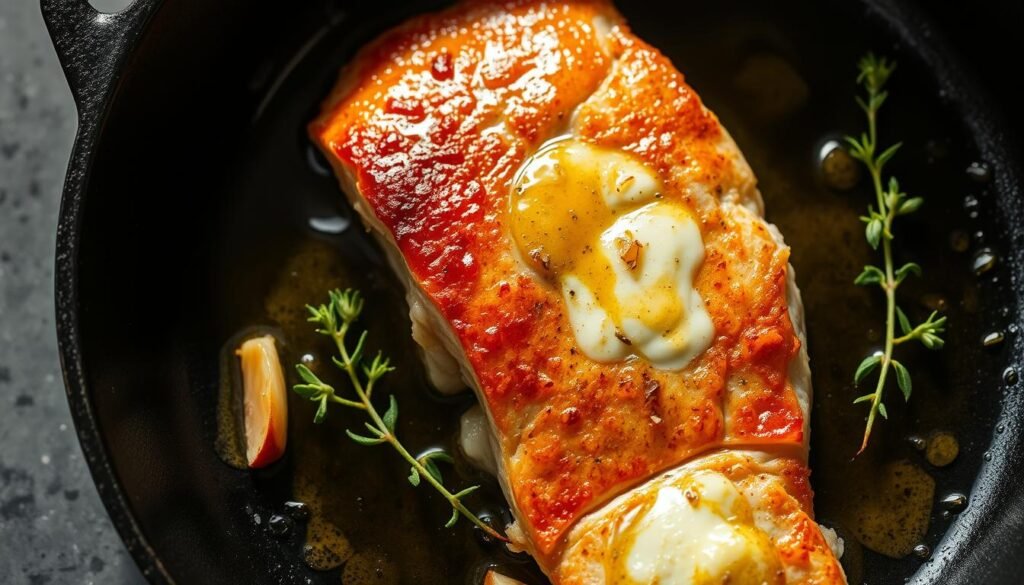
Getting the Pan and Oil to the Perfect Temperature
The first step in achieving a crispy exterior is heating the pan and oil to the right temperature. For a crispy pan fried snapper, it’s essential to use a thermometer to ensure the oil has reached the ideal temperature, typically between 175°C to 190°C. This temperature range allows for a golden crust to form without burning the fish.
While waiting for the oil to heat up, ensure that your snapper is ready to go into the pan. This means having your seasoning and coating applied evenly. The heated pan should be smoking slightly, indicating it’s ready for the fish.
Proper Fish Placement and Handling
Gently placing the snapper in the hot pan is crucial to avoid splashing oil. Start with the presentation side down if you’re cooking fillets, or belly side down if cooking whole. Let the fish cook undisturbed for a few minutes to allow the crust to form.
It’s essential to handle the fish gently to prevent damaging the coating. Use a spatula that’s large enough to support the fish, and avoid pressing down, which can squeeze out juices and make the fish dry.
Knowing When to Flip
Determining when to flip the crispy fish recipe is key to even cooking. The general rule is to flip when the edges start to turn opaque and the crust is golden.
Visual Cues for Perfect Timing
Keep an eye on the fish for visual cues: the crust should be golden and firm to the touch. If you’re unsure, gently lift the edge with a spatula. For fillets, cook for about 3-4 minutes on the first side and 2-3 minutes on the second. Adjust the time based on the thickness of your snapper.
By mastering these techniques, you’ll be well on your way to creating a truly crispy pan fried snapper that delights the senses.
Step-by-Step Cooking Process
To cook a crispy pan-fried snapper, follow this detailed step-by-step guide. The process involves several key phases that ensure your snapper is cooked to perfection.
Initial Searing Phase
The initial searing phase is crucial for achieving that perfect crisp on your pan-fried snapper. Heat your pan to a high temperature before adding a generous amount of oil. Once the oil is hot, gently place your seasoned snapper into the pan. You should hear a sizzle as it hits the pan; this indicates that the cooking process is starting correctly.
Managing Heat Throughout Cooking
After the initial sear, it’s essential to manage the heat to prevent burning and ensure even cooking. Reduce the heat to medium-low and continue cooking. This step is vital for cooking the snapper through without overcooking the exterior.
Testing for Doneness
There are two reliable methods to check if your snapper is cooked: the fork test and checking the internal temperature.
The Fork Test vs. Internal Temperature
The fork test involves gently inserting a fork into the thickest part of the fish and twisting it slightly. If the fish flakes easily, it’s done. Alternatively, you can check the internal temperature, which should reach 63°C for cooked fish.
| Method | Description | Reliability |
|---|---|---|
| Fork Test | Gently insert a fork into the thickest part and twist | High |
| Internal Temperature | Check temperature reaches 63°C | Very High |
Troubleshooting Common Issues
Despite careful planning, issues like sticking, uneven cooking, and overcooking can arise when preparing crispy pan-fried snapper. Knowing how to address these problems can make a significant difference in the quality of your final dish.
Fixing Sticking Problems
One of the most frustrating issues is when the fish sticks to the pan. To prevent this, ensure your pan is hot enough before adding the fish, and use the right amount of oil. A non-stick pan or a well-seasoned cast-iron skillet can also help. If the fish still sticks, try gently loosening it with a spatula.
Addressing Uneven Cooking
Uneven cooking can result from incorrect heat management or not adjusting the cooking time based on the fish’s thickness. To address this, use a thermometer to ensure your pan is at the right temperature, and adjust the heat as needed during cooking. For thicker fillets, consider finishing the cooking in the oven to ensure even doneness.
Salvaging Overcooked Fish
Overcooking can make the fish dry and tough. If you notice your fish is overcooking, remove it from the heat immediately and let it rest. Sometimes, a quick sauce or additional moisture can salvage overcooked fish. Consider serving it with a rich and creamy sauce to mask any dryness.
| Issue | Solution |
|---|---|
| Sticking | Use a non-stick pan, ensure the pan is hot, and use enough oil. |
| Uneven Cooking | Adjust heat, use a thermometer, and consider oven finishing. |
| Overcooking | Remove from heat, let rest, and serve with a moist sauce. |
Delicious Sauce Pairings for Your Crispy Snapper
Elevate your crispy pan-fried snapper with a range of delicious sauce pairings that complement its flavors. The right sauce can enhance the dish, adding a new dimension to the meal.
Classic Australian Sauce Options
Australia is known for its fresh seafood, and the sauces that accompany it are just as important. A classic lemon butter sauce is a staple in many Australian kitchens, and for good reason. It’s simple, yet it brings out the best in the snapper.
Simple Lemon Butter Sauce Recipe
To make a simple lemon butter sauce, you’ll need:
- 100g butter
- 2 lemons, juiced
- 2 cloves garlic, minced
- Salt and pepper to taste
- Fresh parsley, chopped (optional)
Combine butter, lemon juice, and garlic in a saucepan over medium heat. Stir until the butter melts, then season with salt and pepper. Serve hot, garnished with parsley if desired.
| Ingredient | Quantity |
|---|---|
| Butter | 100g |
| Lemon Juice | 2 lemons |
| Garlic | 2 cloves |
Asian-Inspired Accompaniments
For those who enjoy a bit of Asian flair, sauces like Soy-Ginger or Sesame Oil with Chili can add a fascinating twist to your crispy snapper. These flavors are inspired by the cuisine of countries like Japan and Thailand, where fish is often the centerpiece of meals.
Check out our guide on pan-fried butter snapper for more inspiration.
Mediterranean Flavour Combinations
The Mediterranean diet is renowned for its health benefits and rich flavors. A sauce made with olive oil, garlic, and herbs like oregano or thyme can complement the snapper beautifully. This combination is not only delicious but also aligns with the fresh, vibrant flavors of the Mediterranean.
Serving Suggestions and Side Dishes
The perfect accompaniments can elevate your crispy pan-fried snapper to a whole new level. Whether you’re cooking for a casual dinner or a special occasion, the right side dishes can make all the difference.
Fresh Summer Salads and Vegetables
During the warmer months, a fresh summer salad is an ideal accompaniment to your crispy pan-fried snapper. Consider a vibrant mix of seasonal vegetables such as zucchini, carrots, and bell peppers, topped with a light citrus vinaigrette. Roasted or grilled vegetables like asparagus or eggplant also pair beautifully with the crispy snapper.
Hearty Winter Side Options
In the colder seasons, heartier side dishes complement the crispy pan-fried snapper nicely. Roasted root vegetables such as sweet potatoes, parsnips, and carrots are not only flavorful but also provide a satisfying contrast in texture. A warm, comforting side of creamy mashed potatoes or a rustic vegetable gratin can also enhance the dining experience.
| Side Dish | Season | Main Ingredients |
|---|---|---|
| Summer Salad | Summer | Zucchini, carrots, bell peppers, citrus vinaigrette |
| Roasted Root Vegetables | Winter | Sweet potatoes, parsnips, carrots, olive oil |
| Creamy Mashed Potatoes | Winter | Potatoes, butter, cream, garlic |
Australian Wine and Beverage Pairings
No Australian meal is complete without a glass of wine. For crispy pan-fried snapper, a crisp Chardonnay or a dry Sauvignon Blanc pairs excellently. For those who prefer beer, a light ale or a craft beer can complement the flavors. Alternatively, a refreshing glass of lemon myrtle-infused water or a citrus spritzer can cleanse the palate between bites.
Conclusion
Mastering the art of cooking crispy pan fried snapper is now within your grasp. By following the steps outlined in this guide, you’ve gained the knowledge to prepare a deliciously crispy fish recipe that’s sure to impress. From selecting the right snapper and preparing it for cooking, to mastering the pan-frying technique, every step has been designed to help you achieve a perfectly cooked dish.
The key to a successful crispy pan fried snapper lies in the details: getting the pan and oil to the right temperature, handling the fish with care, and cooking it to the perfect doneness. With these tips and techniques under your belt, you’re ready to experiment with different seasoning and coating options to create your own signature crispy fish recipe.
Whether you’re cooking for a special occasion or simply looking to elevate your weeknight meals, crispy pan fried snapper is a versatile and impressive dish that’s sure to become a staple in your kitchen. So, get cooking and enjoy the delicious flavors of a perfectly cooked crispy pan fried snapper.
